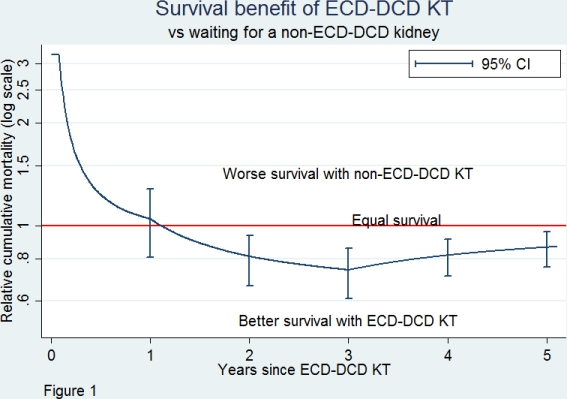Survival Benefit of Kidney Transplantation With Expanded Criteria Kidney from Donors After Circulatory Death
Johns Hopkins, Baltimore.
Meeting: 2015 American Transplant Congress
Abstract number: 291
Keywords: Donors, Kidney transplantation, non-heart-beating, Survival
Session Information
Session Name: Concurrent Session: Kidney: KDPI and Non Ideal Kidneys
Session Type: Concurrent Session
Date: Monday, May 4, 2015
Session Time: 4:00pm-5:30pm
 Presentation Time: 4:12pm-4:24pm
Presentation Time: 4:12pm-4:24pm
Location: Room 118-AB
The purpose of this study was to compare the mortality risk and survival benefit of transplant with expanded criteria kidneys from donors after circulatory death (ECD-DCD) versus a conservative approach (remain on the waitlist and receive non-ECD-DCD kidneys).
METHODS: Discard rate of ECD-DCD kidneys was calculated and compared to that of non-ECD-DCD kidneys. We used time-dependent Cox regression to estimate the mortality risk and cumulative mortality associated with ECD-DCD transplant among kidney-only adult registrants without previous transplant, adjusting for registrant characteristics and transplant center. Interaction terms were used to study effect modification. We plotted relative cumulative mortality for ECD-DCD recipients vs conservative approach, using a bootstrap for 95% CIs.
RESULTS: The discard rate was 49.1% for ECD-DCD kidneys but only 17% for non-ECD-DCD kidneys in 2002-2014. During this period, among 316,973 kidney-only adult registrants, 941 received ECD-DCD transplant. Median time to ECD-DCD was 1.8 years. ECD-DCD transplant conferred higher mortality risk within the first month post-transplant (aHR=2.00 3.19 5.06, p<0.001) but lower risk afterwards (aHR for 1-12 months, 0.66 0.87 1.14, p=0.32; 13-36 months, 0.46 0.58 0.74, p<0.001; >36 months, 0.86 1.03 1.23, p=0.7). Figure 1 compares the adjusted cumulative mortality of receipt of ECD-DCD to that of the conservative approach. ECD-DCD recipients had equivalent cumulative survival at 13.5 months post-transplant and survival benefit thereafter. The cumulative mortality ratio was 0.76 0.86 0.96 at 5-years post-transplant.

The mortality risk and survival benefit was consistent across recipient gender, race, blood type, kidney disease, malignancy, PRA, transplant year, transplant centers but varied by age. Registrants with age≥70 had significantly higher mortality risk (HR: 3.32 6.38 12.27, p<0.001) within the first month post-transplant but non-inferior cumulative mortality ratio (0.71 0.90 1.14) at 5 years.
CONCLUSIONS: ECD-DCD transplantation conferred survival benefit to recipients, especially to recipients age<70. Many ECD-DCD kidneys are viable organs and may be underutilized.
To cite this abstract in AMA style:
Luo X, Massie A, Chow E, Segev D. Survival Benefit of Kidney Transplantation With Expanded Criteria Kidney from Donors After Circulatory Death [abstract]. Am J Transplant. 2015; 15 (suppl 3). https://atcmeetingabstracts.com/abstract/survival-benefit-of-kidney-transplantation-with-expanded-criteria-kidney-from-donors-after-circulatory-death/. Accessed December 28, 2025.« Back to 2015 American Transplant Congress
